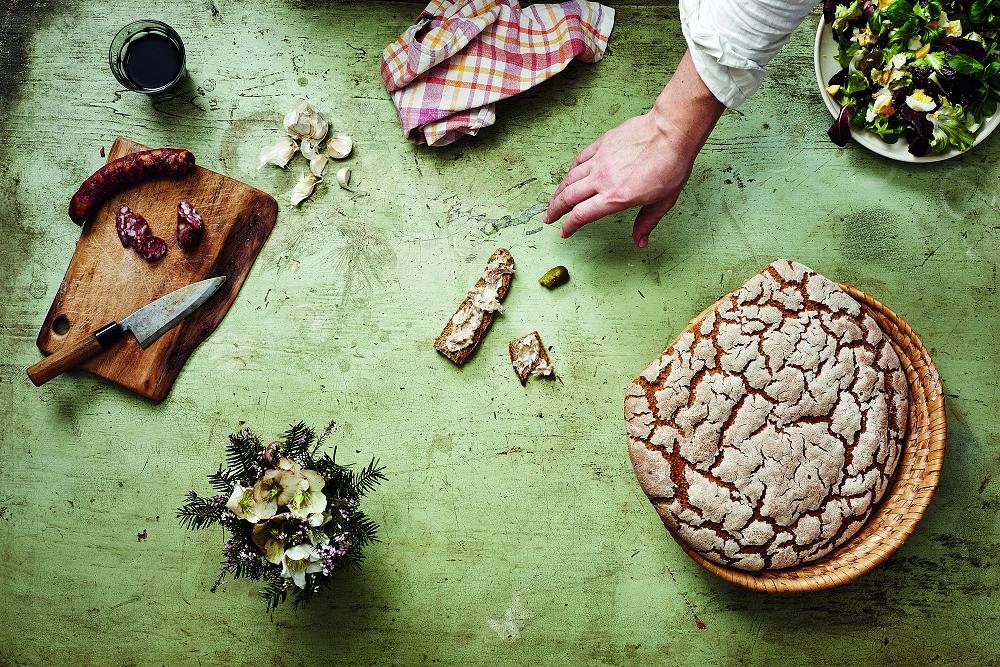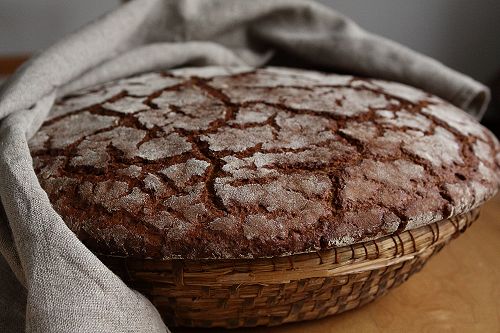
O’Ryelly
Aromatic round rye loaf with kefir starter
My heart beats for rye bread; it’s so fragrant, with full, sweet and sour flavour and a moist crumb. It goes with practically everything and everyone, so it just calls for socialising and company of other dishes. High in pentosans that, together with fibre, absorb water like a sponge, it stays fresh for up to a week, which makes for a genuine ecological statement. And it’s modest – rye flour usually sits on the lowest shelf in the store and costs only a third of the price you would pay for the popular and trendy spelt flour. Should I ever have to reach for only one type of bread to chew on for the rest of my days, it would be rye. O'Ryelly takes a step forward, incorporating wholegrain wheat flour and kefir into a wholesome and tasty compromise.
One round loaf
SPONGE
- 500 g wholegrain rye flour
- 300 g wholegrain wheat flour
- 500 ml full-fat kefir
- (can be replaced with an equal amount of water)
- 300 ml cold water
- 5 g fresh yeast
FINAL DOUGH
- mature sponge
- 200 g wholegrain rye flour
- 18 g sea salt
- 100 g strong wheat flour for handling and dusting
- a handful of rye, wheat or spelt bran for the base
EQUIPMENT
- rectangular sheet pan
Sponge: Pour the kefir into a large bowl. Dissolve the yeast in cold water and add the mixture to the kefir. Stir the liquid with a wooden spoon and gradually add flour, starting with rye and finishing with wheat flour. Stir until you have a thin, homogenous, lump-free mixture. Cover the bowl with a wet tea towel and leave the sponge to mature at room temperature overnight or about 8 hours. This will allow the sponge to bubble and slightly swell.
Kneading: Salt the mature
sponge and thicken with the remaining rye flour. Stir with a wooden spoon until
the flour has absorbed all the liquid and you get a sticky, dense mixture.
Maturation: Cover the dough with
a wet tea towel and leave to rest for 20 minutes. Stir again quickly, cover
with the towel and leave to rest for another 20 minutes.
Shaping: Dust
the work surface with strong flour and transfer the dough from the bowl. Now
dust the surface of the dough as well and then knead it quickly but firmly, by
folding the edges, one after another, towards the centre. Dust with more flour if it’s too sticky. You now have a round loaf.
Sprinkle the bottom of a sheet pan with bran and place the loaf with the rough side down to hide the folds.
Dust the surface of
the loaf with flour and press it down with the heel of your hand to flatten it
out a little. With your fingers and the palm of your hand gently massage the
surface of the dough with circular movements, rubbing the flour into the
surface to smooth it out and flatten out the loaf a little more. Sprinkle
with more flour if necessary, as you need friction between your hand and the
dough.
Proofing: Cover the dough with
a tea towel and leave to mature for about 2 hours. This
is the time for fermentation to take place: gases will be released and
the top of the dough will start to rise and crack, giving the bread its
distinctive appearance.
Half an hour before
you stop proofing, preheat the oven to 240°C and place the rack at the bottom
of the oven.
Baking: Before baking, dust
the proofed cracked loaf with strong flour and place the pan with the loaf into
the preheated oven. Bake at high temperature for the first 6 minutes, then
lower to 220°C and bake for another 40–45 minutes, depending on how thick
your loaf is.
Take the baked bread
out of the oven and transfer it to a wire rack or somewhere with good air
circulation and leave to cool for at least 2 hours – or even better,
overnight.
TIP: Kefir is used in baking for its high content of milk
bacteria. When you knead dough with kefir culture you accelerate the
development of bacteria that endow bread with its pleasant flavour and aroma.
While fats give kefir bread a softer taste and denser structure, they also make
the bread dry more quickly and reduce its shelf life. To extend your bread’s
shelf life you can leave out kefir and replace it with the same amount of
water.
Gallery



